|
Contents
HB 1079 Round #3 Segment Committee Meetings
Each of the three Segment Committees met through an online platform between April 1-3, 2020. Despite the significant impact of the coronavirus in many of the communities of the local elected officials, the online meetings, which lasted four hours per committee, were well attended.
Federal Guidance on Interstate Designation
Segment Committees heard and discussed the legal processes of how a highway becomes an interstate highway. Below are the three methods:
- Method #1 - The U.S. Secretary of Transportation may designate a highway currently built to interstate standards as an Interstate Highway.
- Method #2 - TxDOT may propose to USDOT to have a highway designated as a Future Addition to the Interstate Highway System. Requirements of this method include:
- Route description and statement of justification
- Statements regarding coordination with adjoining states, responsible local officials, and officials of areas under federal jurisdiction
- Consideration based on six evaluation criteria
- A highway:
- Must be a logical addition or connection to the Interstate Highway System
- Have affirmative recommendation of the TxDOT
- Have written agreement with TxDOT that corridor will be constructed to meet interstate standards within 25 years of the agreement with FHWA Administrator
- Must be on the National Highway System
- Once the Future Interstate is constructed to Interstate Standard, it becomes an Interstate Highway System.
- Method #3 - Congress may designate a highway as a future addition to the Interstate Highway System.
- No specific requirements are attached to this method
- Once the Future Interstate is constructed to Interstate Standard, it becomes an Interstate Highway System.

Interstate with Frontage Roads Cross Section

Interstate Without Frontage Roads Cross Section
Preliminary Cost Estimates
The committee reviewed the initial cost estimates provided by the consultant team for the complete Texas corridor and for each Segment. Estimates included the following assumptions:
- Assumes locally preferred routes (relief routes)
- Provides two estimates; one for frontage roads throughout and one for frontage roads in cities and towns
- Right-of-way estimated as a percentage of the construction costs
- Adjusts for planned and programmed projects
- Includes major utilities
- Parallel pipelines
- Oil and gas wells
- Water wells
- Parallel railroad
These planning estimates will continue to be refined for future discussion following input from the committees.
Preliminary Committee Recommendations
Each Committee reviewed items that had been raised earlier in the process that addressed infrastructure improvements associated with safety, additions to capacity, and local preferred routes. Further discussions focused on additions to these infrastructure improvements which were captured on an interactive map.
Developing Committee Recommendations are one of the most important aspects of each Segment Committee. The importance of these recommendations led each Segment Committee to create a Subcommittee to draft final Committee Recommendations for later review by the full Segment Committee.
Funding Sources
Federal, State and Local funding for Interstate Highways was reviewed and discussed. The Committees requested that a description of the TxDOT Development Process and the opportunities presented by the 12 funding categories in the Unified Transportation Plan (UTP) that might benefit development of the corridor as an Interstate Highway.

Economic Analysis
Discussion on the Economic Analysis was tabled until the next meeting to give the consulting team more time to finalize.

Thank You
The Ports-to-Plains Alliance would like to give a thank you for participatio of local elected officials and leaders that continue to participate in the Feasibility Study Process. This thank you is also extended to the TxDOT staff and the consulting team for their diligence in providing information to each Segment Committee and their willingness to listen to the Committee inputs.
HB 1079 requires that the Segment Committee Reports be completed and approved by June 30, 2020.
Return to Contents
Upcoming HB 1079 Segment Committee Meetings

The fourth set of Segment Committee meetings for the Ports-to-Plains Feasibility Study are scheduled for the week of May 11, 2020.
- Segment 1 - New Mexico and Oklahoma borders to Hale/Lubbock County line
- May 14, 2020
- Time: 8:00 am – 12:00 pm (CDT)
- Online Meeting
- Segment 2 - Hale/Lubbock County line to Sutton/Edwards County line
- May 13, 2020
- Time: 8:00 am – 12:00 pm (CDT)
- Online Meeting
- Segment 3 - Sutton/Edwards County line to I-35/Juarez-Lincoln Bridge in Laredo
- May 11, 2020
- Time: 8:00 am – 12:00 pm (CDT)
- Online Meeting
Each committee will review the Economic Analysis, Implementation Plan, Report Chapters 5 and 6 and Draft the Final Segment Committee Report.
Return to Contents
Ports-to-Plains Feasibility Study Public Hearings
TxDOT has announced the schedule for an additional round of Public Meetings for the Ports-to-Plains Corridor Feasibility Study including one for each Segment. TxDOT will host live online virtual public meetings to present information on the Ports-to-Plains Corridor Feasibility Study. This will be an online webinar format meeting which will include a live presentation and comment opportunity via WebEx.
Segment #1 -- New Mexico and Oklahoma borders to Hale/Lubbock County line
The Segment 1 public meeting will be held on Thursday, May 14, 2020, via WebEx at 4:00 p.m. (CDT). The meeting will be recorded and available online for the public to view through Friday, May 29, 2020. Please note that no in-person meeting is being scheduled.
Webinar Link: https://txdot.webex.com/txdot/j.php?MTID=m0aae6ed2f08386dfb44510357eb9aa8a
Meeting password: P2PStudy
Select the option for WebEx to call you, then enter your phone number, submit, and answer the call, or:
Join by phone: (415) 655-0003
Meeting number (access code): 476 535 117
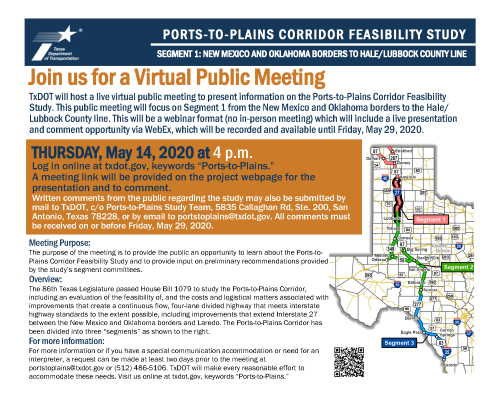
Segment #2 – Hale/Lubbock County line to Sutton/Edwards County line
The Segment 2 public meeting will be held on Wednesday, May 13, 2020, via WebEx at 4:00 p.m. (CDT). The meeting will be recorded and available online for the public to view through Thursday, May 28, 2020. Please note that no in-person meeting is being scheduled.
Webinar Link: https://txdot.webex.com/txdot/j.php?MTID=mf57cd84257fa515024d5bd2afaf5f630
Meeting password: P2PStudy
Select the option for WebEx to call you, then enter your phone number, submit, and answer the call, or:
Join by phone: (415) 655-0003
Meeting number (access code): 475 224 192
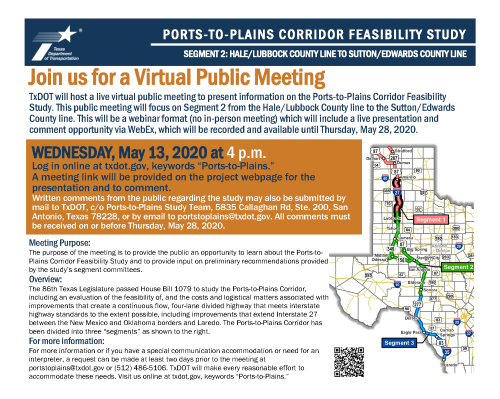
Segment #3 -- Sutton/Edwards County line to I-35/Juarez-Lincoln Bridge in Laredo
The Segment 3 public meeting will be held on Monday, May 11, 2020, via WebEx at 4:00 p.m. (CDT). The meeting will be recorded and available online for the public to view through Tuesday, May 26, 2020. Please note that no in-person meeting is being scheduled.
Webinar Link: : https://txdot.webex.com/txdot/j.php?MTID=m801f2777c7e7065767635dc6fea12ed9
Meeting password: P2PStudy
Select the option for WebEx to call you, then enter your phone number, submit, and answer the call, or:
Join by phone: (415) 655-0003
Meeting number (access code): 476 309 877
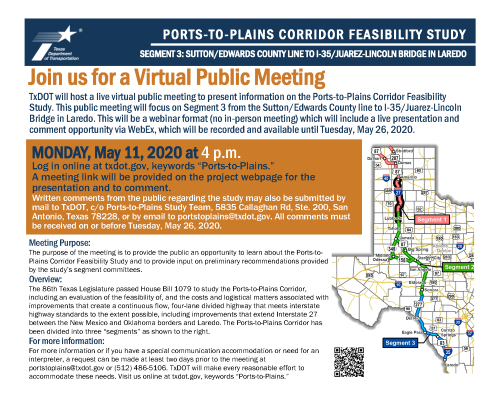
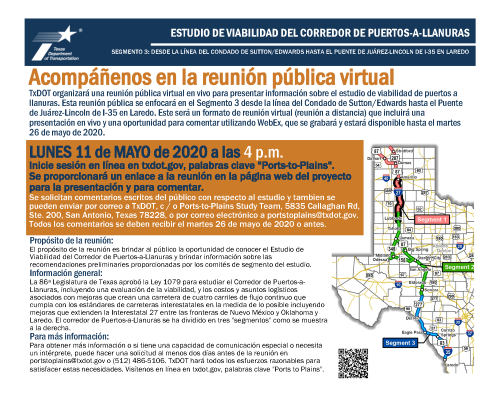
Return to Contents
U.S. Chamber of Commerce "Phase 4" Infrastructure Update w/ Ed Mortimer
The Lubbock Chamber of Commerce is inviting Ports-to-Plains members to join them for a call with Ed Mortimer, vice president of Transportation and Infrastructure at the U.S. Chamber of Commerce. This zoom call will provide an update to the potential of a Phase 4 Infrastructure Bill by Congress.
Time: May 1, 2020 10:30 AM Central Time (US and Canada)
Join Zoom Meeting: https://zoom.us/j/91580765743
Meeting ID: 915 8076 5743
Dial by phone: 346 248 7799 US
Return to Contents
Importance of Texas-Mexico Border
In 2019, the nine-state areas served by the Ports-to-Plains Corridor traded over 78.3 billion in goods across the Texas-Mexico border using the ports of entry at Laredo, Eagle Pass and Del Rio. As the Texas-Mexico Border Transportation Master Plan continues to be developed, the importance of this trading relationship is clear. Below are some of the key data points about the trading relationship across the Texas-Mexico Border.

The Texas-Mexico border connects the people and commerce of the United States and Mexico. The two countries share a 1,954-mile common border—64 percent (1,254 miles) is shared between Texas and Mexico. The U.S.-Mexico border is North America’s busiest trade gateway. Mexico is the third-largest trading partner of the U.S. and 70 percent of trade between the two countries passes through the Texas-Mexico border.
U.S.-Mexico trade supports more than 5 million jobs across the U.S. and Texas-Mexico trade supports more than 382,000 jobs in Texas. The Texas-Mexico border region is growing—outperforming the U.S. and Mexico in population growth. The region added about 3 million residents from 1990 to 2017.

The Laredo Customs District includes the ports of entry at Laredo, Eagle Pass and Del Rio. Five of the top ten U.S. border crossings with Mexico are in the Laredo Customs district, led by Port Laredo and including Pharr, Brownsville, Eagle Pass and Del Rio. U.S. Trade with Mexico through the Laredo Customs District total $327 billion including $193 billion in imports and $134 billion in exports.
In terms of agriculture products exported through the Laredo Customs District, corn ranks third in the nation; second in the nation for pork; and second in the nation for chicken. For motor vehicles exports, the Laredo Customs District led the nation for motor vehicle parts surpassing Detroit; tires and diesel engines were more than 50 percent of U.S. exports.
Click on the image below for a free download of the 2019 Laredo by the Numbers, published by World City (ustradenumbers.com).
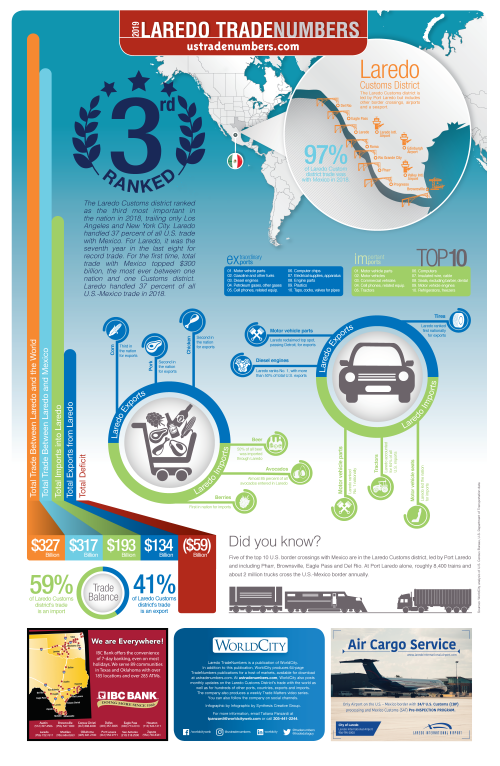
Return to Contents
Work Re-starts on Long-X Bridge
Cal Klewin, Executive Director of the Theodore Roosevelt Expressway Association was provided an opportunity by Ames Construction to do a tour of the construction site of the new four-lane Long X Bridge. The project is moving on schedule and there is equipment (big) and people moving everywhere on site. Seventy people are on site and they are working 12 hour days and 6 days a week.
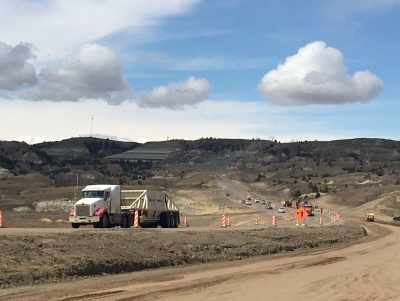
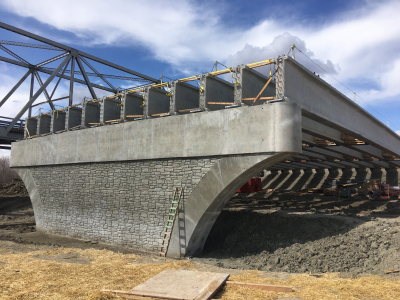
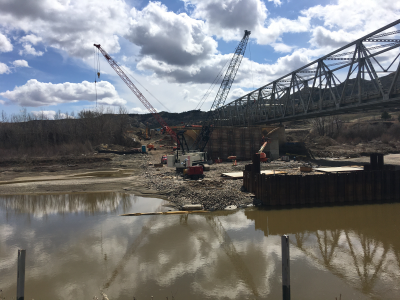
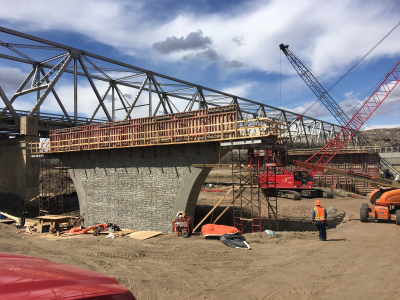
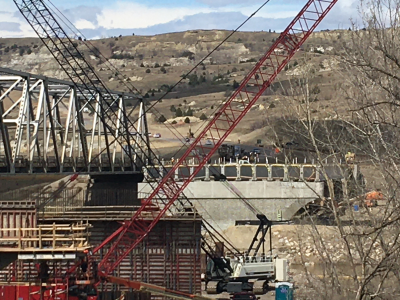
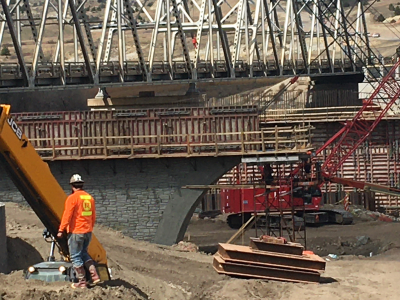
Return to Contents
|